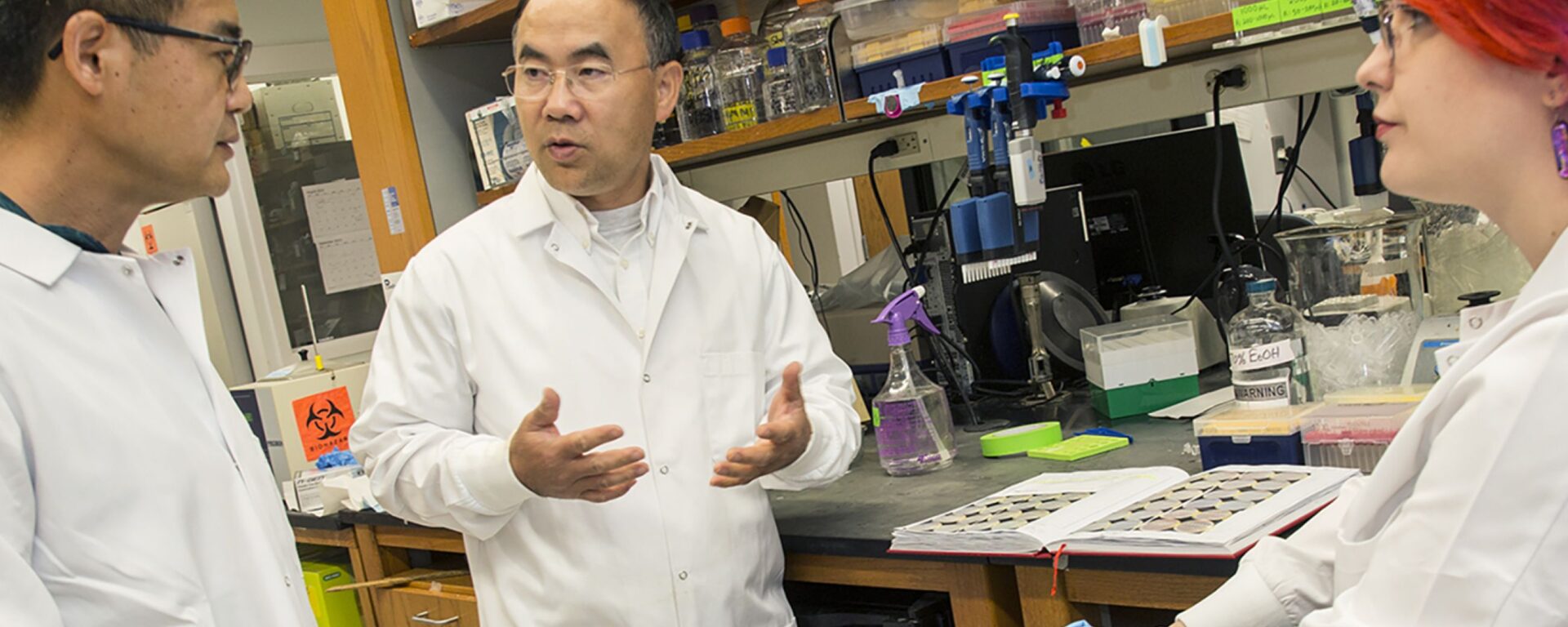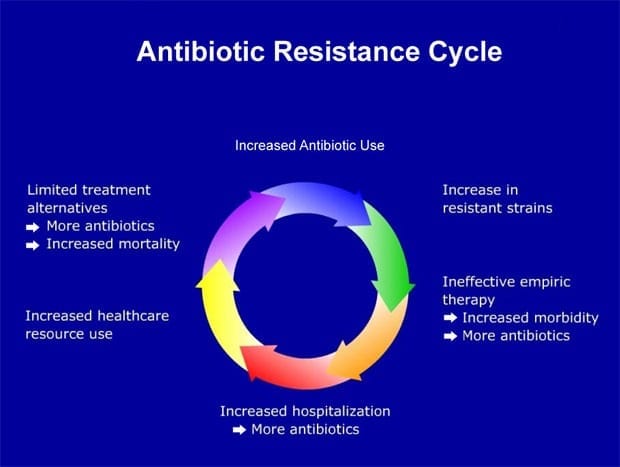
via Duke University
Decades of work by a series of Duke investigators yields new drug, patents and a startup company
A scientific journey decades in the making at Duke University has found a new antibiotic strategy to defeat gram-negative bacteria like Salmonella, Pseudomonas and E. coli, the culprits in many urinary tract infections (UTIs). The synthetic molecule works fast and is durable in animal tests.
It works by interfering with a bacterium’s ability to make its outer lipid layer, its skin, so to speak.
“If you disrupt the synthesis of the bacterial outer membrane, the bacteria cannot survive without it,” said lead investigator Pei Zhou, a professor of biochemistry in the Duke School of Medicine. “Our compound is very good and very potent.”
The compound, called LPC-233, is a small molecule that has proven effective at wrecking the outer membrane lipid biosynthesis in every gram-negative bacterium it was tested against. Co-authors at the University of Lille in France tested it against a collection of 285 bacterial strains, including some that were highly resistant to commercial antibiotics, and it killed them all.
And it works fast. “LPC-233 can reduce bacterial viability by 100,000-fold within four hours,” Zhou said.
The compound is also tenacious enough to survive all the way to the urinary tract after oral administration, which may make it a vital tool against stubborn urinary tract infections (UTIs).
Tests run at high concentrations of the compound showed “exceedingly low rates of spontaneous resistance mutations in these bacteria,” according to a paper describing the findings, which appears Aug. 9 in Science Translational Medicine.
In animal studies, the compound was successful when administered orally and intravenously or injected into the abdomen. In one experiment, mice given what should have been a fatal dose of multidrug-resistant bacteria were rescued by the new compound.
The search for this compound took decades because of the specificity and safety required of the synthetic molecule.
Zhou credits his late colleague, former Duke Biochemistry Chair Christian Raetz, for starting the search decades ago. “He spent his entire career working on this pathway,” Zhou said. “Dr. Raetz proposed a conceptual blueprint for this pathway in the 1980s, and it took him over two decades to identify all of the players,” Zhou said.
The new drug’s target is an enzyme called LpxC that is the second enzyme in the “Raetz pathway” and is essential to making the outer membrane lipid in gram-negative bacteria.
Raetz joined Duke as the chairman of biochemistry in 1993 after his work on this pathway at Merck & Co. had failed to produce a successful clinical candidate. The Merck antibiotic worked, but only against E. coli, so it wasn’t commercially viable and the pharmaceutical company dropped it.
“He actually recruited me to Duke to work on this enzyme, initially just from the structural biology perspective,” said Zhou, who came to Duke in 2001.
Zhou and Raetz had solved the structure of the LpxC enzyme and revealed molecular details of a few potential inhibitors. “We realized that we could tweak the compound to make it better,” Zhou said. Since then, Zhou has been working with his colleague, Duke Chemistry professor Eric Toone, to make more potent LpxC inhibitors.
The first human trial of LpxC inhibitors had failed because of cardiovascular toxicity. The focus of the Duke group’s subsequent work was to avoid cardiovascular effects while maintaining the potency of the compound.
They worked on more than 200 different versions of the enzyme inhibitor, always searching for better safety and more potency. Other compounds worked to varying degrees, but compound number 233 was the winner.
LPC-233 fits a binding spot on the LpxC enzyme and prevents it from doing its work. “It fits in the right way to inhibit formation of the lipid,” Zhou said. “We’re jamming the system.”
Adding to its durability, the compound works by a remarkable two-step process, Zhou said. After the initial binding to LpxC, the enzyme-inhibitor complex changes its shape somewhat to become an even more stable complex.
The lifetime of the inhibitor binding in this more stable complex is longer than the lifetime of the bacteria. “We think that contributes to the potency, as it has a semi-permanent effect on the enzyme,” he said. “Even after the unbound drug is metabolized by the body, the enzyme is still inhibited due to the extremely slow inhibitor dissociation process,” Zhou said.
There are multiple patents being filed on the series of compounds, and Toone and Zhou have co-founded a company called Valanbio Therapeutics, Inc. which will be looking for partners to bring LPC-233 through phase 1 clinical trials to assess safety and efficacy in humans.
“All of these studies were done in animals,” Zhou said. “Ultimately the cardiovascular safety needs to be tested in humans.”
Original Article: Synthetic Antibiotic Could Be Effective Against Drug-Resistant Superbugs
More from: Duke University | University of Lille
The Latest Updates from Bing News
Go deeper with Bing News on:
Synthetic antibiotic
- New synthetic drug hidden in heroin and cannabis vapes is flooding Scotland
Scotland's drug harms early warning system has issued an alert for a synthetic drug which is being detected in overdoses and deaths across Scotland. The alert for xylazine has been issued by Rapid ...
- The Future of Antibody-Drug Conjugates in Lung Cancer Treatment
Drs Jacob Sands and Benjamin P. Levy discuss antibody-drug conjugates in lung cancer treatment, including differences in efficacy, toxicity profiles, and what the future holds.
- Italy looks to US, China, UN to combat Fentanyl, synthetic drug abuse
G7 president Italy is ready to work with the United States, China and the United Nations in the 'global battle' against abuse of synthetic opiate fentanyl and others, foreign minister Antonio Tajani ...
- AG Kris Mayes pledges Arizona will ramp up extradition of drug traffickers from Mexico
Extradition involves coordination with the federal government and untangling a patchwork of international treaties and foreign laws.
- Synthetic biology market to rise at a 25.6% CAGR until 2027
A report by Technavio revealed that the market is driven by the growing application of synthetic biology, along with the rising demand for synthetic genes and cells. However, the complexity of ...
Go deeper with Bing News on:
LPC-233
- Heather Liebe
New clients welcome! We all have times in our lives when we feel overwhelmed by stress, anxiety, sadness, or are going through a big life change. As a therapist with over a decade of experience, I ...
- LFM Properties Corp LPC
Morningstar Quantitative Ratings for Stocks are generated using an algorithm that compares companies that are not under analyst coverage to peer companies that do receive analyst-driven ratings ...
- Red Sox and 23-year-old Ceddanne Rafaela finalize an 8-year contract
BOSTON (AP) — The Boston Red Sox finalized an eight-year contract Wednesday with 23-year-old Ceddanne Rafaela, the youngest player on their roster. The deal includes a team option for 2032.
- Shelter Shares Difference in Dog on Day 1 and Day 233: 'Losing Hope'
Despite her entire litter being rehomed, Pinky, a former stray who had been found pregnant by Chicago Animal Care & Control, is still searching for a forever home. The dog has now spent more than ...
- 5 things about the new school voucher program OK’d by Kemp
Brian Kemp. Senate Bill 233, the Georgia Promise Scholarship Act, establishes a taxpayer-funded program that might initially cost $140 million a year. It creates a “voucher” program for ...










